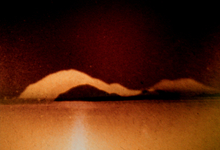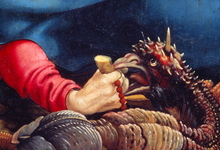- Images (8)
- Links (1)
- Agenda

|

|

|

|

|

|

|

|
Screening introduced by Nicole Brenez
These days, a large number of film analyses are conducted via image and sound: « true » analyses, in the words of Jean-Luc Godard. It is not so much related to the « digital revolution » as it is a return to origins, since, just 200 years ago, in the course of research started in 1818 and that would lead to the invention of photography, Nicéphore Niepce began to make heliography engravings: and so, at the beginning of the route toward analog photochemistry, we find images of images. From there, a surprisingly ample formal spectrum would open up: it would range from such extremes as Othello Vilgard's sublime Amor (2013), a study of Epsteinian esthetics without a single Epstein shot nor the slightest hint of traditional argumentation, to the voluntarily ultra-didactic – and no less sublime – reflexions of the Groupe Cinéthique, starting with the indispensable and still too little-known Quand on aime la vie, on va au cinéma (1975). Among the landmarks in the esthetic history of visual analysis, apart from such classics as those of Buster Keaton, Dziga Vertov or Michelangelo Antonioni / Brian De Palma, the following must be mentioned: the seminal Rien que les heures by Alberto Cavalcanti (1926), Chantal D., star by Maurice Lemaître (1968), Bande de cons! by Roland Lethem (1970), Visual Studies: Origins of the Film by Al Razutis (1973-1984), Gradiva Esquisse 1 by Raymonde Carasco (1978), Déjà le sang de mai ensemençait novembre by René Vautier (1987), Cézanne by Jean-Marie Straub & Danièle Huillet (1989), Chic Point by Sharif Waked (2003), Transformers. The Premake by Kevin Lee (2014)... and, of course, all the films of Jean-Luc Godard, Guy Debord, Ken Jacobs, Angela Ricci-Lucchi & Yervant Gianikian, Harun Farocki, Peter Tscherkassky. We can also place in this wall-less pantheon of visual studies I Don't Think I Can See an Island by Christopher Becks & Emmanuel Lefrant and Maître Mathis by Gisèle Rapp-Meichler. Owing to the magnetic field which emerges between the film's title and its images, the first film offers the most beautiful definition of the properties and figurative powers of analog cinema. Due to its documented point of view (in the sense of Jean Vigo), the second film elucidates and maximally deploys the critical dimension of an artistic work, that of the mysterious painter Mathias Grünewald, with the magical rigor that characterizes Gisèle Rapp-Meichler.
Nicole Brenez

|
I DON'T THINK I CAN SEE AN ISLAND
by Christopher BECKS & Emmanuel LEFRANT 2016 / 35mm / color / sound / 4' 10 |

|
MAÎTRE MATHIS
by Gisèle RAPP-MEICHLER 2008 / Video / color / sound / 53' 00 |
| address |
Studio des Ursulines 10, rue des Ursulines 75005 Paris France |
|---|---|
| metro | Line 7 (Censier Daubenton) or RER B (Luxembourg) |
| lightcone@lightcone.org | |
| related link |
Join the event on Facebook
|
| rates | single rate: 6.80 € |